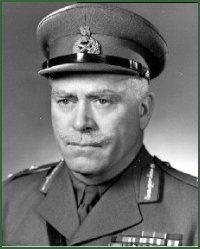Allegiance Canada Rank Major general | Name Christopher Vokes | |
 | ||
Unit Royal Canadian Engineers Commands held 2nd Canadian Infantry Brigade1st Canadian Infantry Division4th Canadian Armoured Division Battles/wars World War IIOperation HuskyBattle of OrtonaBattle of the Hochwald Died March 27, 1985, Oakville, Canada Awards Order of the Bath, Order of the British Empire, Distinguished Service Order, Canadian Forces Decoration Battles and wars | ||
Major General Christopher Vokes (13 April 1904–27 March 1985) was a senior Canadian Army officer who fought in World War II.
Contents

Family
Born in Armagh, Ireland, the son of a British officer, Major Frederick Patrick Vokes and Elizabeth Vokes, who came to Canada in 1910. Major Frederick Patrick Vokes was the engineering officer at the Royal Military College of Canada. The family lived in Married Quarters at Ridout Row, Royal Military College of Canada.
Christopher Vokes' brother, Lieutenant-Colonel Frederick Alexander Vokes (RMC 1926–1930, #1940), took a leading part in the assault on Dieppe in August 1942. In early 1944 he was sent to Italy as commanding officer of the 9th Armoured Regiment (The British Columbia Dragoons). On August 31, 1944, Frederick Alexander Vokes, Royal Canadian Dragoons, was seriously wounded in action and died in a field hospital in Italy after being hit by a German shell while standing beside his tank September 4, 1944.
Military service
From 1921 to 1925, he attended the Royal Military College of Canada #1633 and was commissioned into the Royal Canadian Engineers. He then attended McGill University from 1926 to 1927 where he received a Bachelor of Science degree and was a member of the Kappa Alpha Society. From 1934 to 1935, he attended Staff College, Camberley in England. In Depression-Era Canada, many military bases were improved by civilians working in relief camps under supervision of professional military officers, including Camp Dundurn. The original engineer drawings for the concrete rifle range butts were signed by Chris Vokes, in that capacity. Barrack Blocks in Dundurn resemble similar buildings constructed at Camp Valcartier in the same time frame.
In 1942, he was promoted to brigadier and was put in charge of the 2nd Canadian Infantry Brigade where he was part of the Allied invasion of Sicily. In 1943, he became commander of the 1st Canadian Infantry Division and promoted to Major-General. He was the commander of the division during the Battle of Ortona, after which he was criticized for unimaginative tactics and frontal assaults.
Montgomery ordered the 1st Canadian Infantry Division to attack along the coast towards Ortona early in December. During an attack on a ravine southwest of Ortona, Vokes continued to send battalion after battalion to attack the mine-fortified German defense for nine days. For this he became known as the "Butcher" among his men. An impatient Montgomery sent messages wondering why the attack took so long. At the same time, the Canadians became aware of the fact that they were fighting not only Panzer-Grenadiers, but also the 1st Parachute Division, whom they recognized by their characteristic helmets. On the 21st December the Canadians broke through, and German forces destroyed the old town: the Fallschirmjägers continued to hold the town ruins for over a week, deploying mines. After the battle, a furious Vokes broke out in tears due to his division's losses – 2300 casualties, among them 500 dead, as well as many cases of war neuroses.
In 1944, he took over command of the 4th Canadian (Armoured) Division and fought in the Battle of the Hochwald.
In 1945 he ordered the systematic destruction by flames and bulldozers of the Northern German city of Friesoythe as reprisal for a killing of one of his subordinates allegedly by a civilian from that town.
From June 1945 to May 1946, he was the General Officer Commanding the Canadian Army Occupation Force in Europe. Returning to Canada, he commanded the Army's Central Command and then Western Command. He retired in 1959.
He died of cancer in Oakville, Ontario in 1985.
